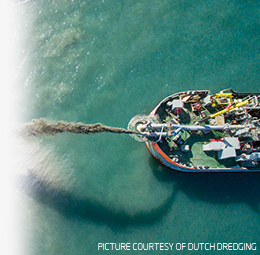SPECIAL REPORT: Dredging
Jump to topic:
❯ OVERVIEW
❯ DREDGING INTERNATIONAL NV
❯ OCEAN DREDGING DSM
❯ DUTCH DREDGING
❯ VAN OORD
DREDGING: OVERVIEW
Beauty and the beast
Dredging is eco-sensitive – but regulators must not price it beyond reach
There is intense pressure on the region’s maritime industry to constantly improve and expand its facilities to meet the demands of international trade and tourism. But this expansion must be balanced with the region’s desire to conserve and protect the outstanding natural beauty of its islands and coasts. A typical dredging project in the Caribbean will cost roughly 50 per cent more than elsewhere because of tough environmental regulations. In this article, consultants Jelle Prins and Luis Prieto call for a more joined-up approach by regulators across the region to ensure that port authorities can afford to keep up with essential dredging.
The Caribbean is a unique region. There are few areas on earth where 13 sovereign island nations and 12 territories with ties to Europe and the United States depend so heavily on waterborne commerce. The region’s pristine beauty and fragile environment also hold great value for the tourism industry, but it remains extremely challenging and costly for the maritime industry.
Navigating the intricate regulatory environment that covers the Caribbean’s 7,000 islands also makes it necessary to understand the areas of low and high dredge frequency and the degrees of regulatory capacity. Some areas enforce disproportionately strict and complex regulations that often hinder the maritime industry’s ability to meet the region’s infrastructural needs.
Impact
The impact of these regulations may not be immediately apparent. Infrastructure projects are critical to a region’s economic well-being and sometimes must be carried out – a shoaled port can have severe and far-reaching economic consequences. In these instances, the consequence of the strict environmental regulation is cost escalation. And these costs are passed directly to the general population through repayment landing fees, head taxes and other costs.
Dredging – the underwater excavation of sediments – encompasses an array of needs. It is used to deepen channels and ports, build and nourish beaches, reclaim lands and for environmental clean-up. The role of the regulatory authority is to establish standards that limit these impacts while still permitting the dredging to proceed.











